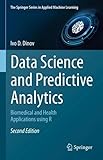Data Science and Predictive Analytics [electronic resource] : Biomedical and Health Applications using R /
Material type: TextSeries: The Springer Series in Applied Machine LearningPublisher: Cham : Springer International Publishing : Imprint: Springer, 2023Edition: 2nd ed. 2023Description: XXXIV, 918 p. 336 illus., 306 illus. in color. online resourceContent type:
TextSeries: The Springer Series in Applied Machine LearningPublisher: Cham : Springer International Publishing : Imprint: Springer, 2023Edition: 2nd ed. 2023Description: XXXIV, 918 p. 336 illus., 306 illus. in color. online resourceContent type: - text
- computer
- online resource
- 9783031174834
- 005.7 23
- Q336
Chapter 1 - Introduction -- Chapter 2: Basic Visualization and Exploratory Data Analytics -- Chapter 3: Linear Algebra, Matrix Computing and Regression Modeling -- Chapter 4: Linear and Nonlinear Dimensionality Reduction -- Chapter 5: Supervised Classification -- Chapter 6: Black Box Machine Learning Methods -- Chapter 7: Qualitative Learning Methods - Text Mining, Natural Language Processing, Apriori Association Rules Learning -- Chapter 8: Unsupervised Clustering -- Chapter 9: Model Performance Assessment, Validation, and Improvement -- Chapter 10: Specialized Machine Learning Topics -- Chapter 11: Variable Importance and Feature Selection -- Chapter 12: Big Longitudinal Data Analysis -- Chapter 13: Function Optimization -- Chapter 14: Deep Learning, Neural Networks.
Complementary to the enormous challenges related to handling, interrogating, and understanding massive amounts of complex structured and unstructured data, there are unique opportunities that come with access to a wealth of feature-rich, high-dimensional, and time-varying information. The topics covered in this textbook address specific knowledge gaps, resolve educational barriers, and mitigate workforce information readiness and data science deficiencies. Specifically, it provides a transdisciplinary curriculum integrating core mathematical foundations, modern computational methods, advanced data science techniques, model-based machine learning (ML), model-free artificial intelligence (AI), and innovative biomedical applications. The book’s fourteen chapters start with an introduction and progressively build the foundational skills from visualization to linear modeling, dimensionality reduction, supervised classification, black-box machine learning techniques, qualitative learning methods, unsupervised clustering, model performance assessment, feature selection strategies, longitudinal data analytics, optimization, neural networks, and deep learning. Individual modules and complete end-to-end pipeline protocols are available as functional R electronic markdown notebooks. These workflows support an active learning platform for comprehensive data manipulation, sophisticated analytics, interactive visualization, and effective dissemination of open problems, current knowledge, scientific tools, and research findings. This Second Edition includes new material reflecting recent scientific and technological progress and a substantial content reorganization to streamline the covered topics. Featured are learning-based strategies utilizing generative adversarial networks (GANs), transfer learning, and synthetic data generation. There are complete end-to-end examples of ML/AI training, prediction, and assessment using quantitative, qualitative, text, and imaging datasets. This textbook is suitable for self-learning and instructor-guided course training. It is appropriate for upper division and graduate-level courses covering applied and interdisciplinary mathematics, contemporary learning-based data science techniques, computational algorithm development, optimization theory, statistical computing, and biomedical sciences. The analytical techniques and predictive scientific methods described in the book may be useful to a wide spectrum of readers, formal and informal learners, college instructors, researchers, and engineers throughout the academy, industry, government, regulatory and funding agencies.


There are no comments on this title.